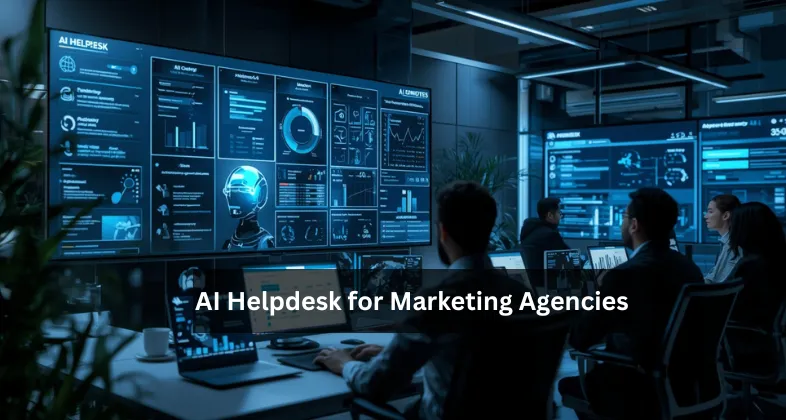The marketing industry is blazingly fast in its actions, with client expectations set at an all-time high. Agencies are expected to give quick answers with transparent communication and always on-the-go support, often with some limitations on the resources put to this task. This is where an AI-powered helpdesk becomes an absolute disruptor. By blending automation with human monitoring, agencies may fast-track client issues, reduce response time, and free staff to devote their energies to creative work. However, such a system needs careful planning before implementation. Below are critical steps in setting up a marketing agency AI helpdesk.
Choose the Right AI Helpdesk Tools
The heart of an excellent AI helpdesk is choosing the right kind of platform. When marketing agencies need a solution for AI chatbots and ticketing systems, plus reporting dashboards all under one roof, they can look at popular names such as Zendesk, Freshdesk, or Intercom, all of which have some good AI add-ons.
Besides these attributes, agencies need to examine scalability. Boutique agencies can start with simple solutions but need to assess whether the tool can scale with the clients. It’s equally vital not to erect silos that could impair productivity and growth when assessing integrations into existing workflows: Slack for team collaboration, or HubSpot for CRM, for instance.
Define Escalation Rules and Human Oversight
AI is robust but cannot substitute the nuance within human judgment. Therefore, escalation rules must be in place. A chatbot should immediately escalate a conversation to a human agent if it detects frustration from the customer or receives a question that is out of its range.
The three levels of support are clearly defined as Tier 1, Tier 2, and Tier 3. Tier 1 encompasses FAQs dealt with by AI or entry-level personnel, while Tier 2 covers more savvy and specialized knowledge from account managers. Training of staff in AI oversight from programs such as IT Technician school can thus be ensured for an efficient human-in-the-loop approach.
Train Your AI Chatbot on Relevant Knowledge
Generic out-of-the-box chatbots are rarely used, with customization achieving value. Agency-specific FAQs, service offerings, and campaign processes should be fed into the chatbots. Also, common client queries like turnaround times for reporting, price tier information, and troubleshooting ad accounts should be trained.
The system is further enhanced by establishing a feedback loop for each failure. Every time the AI is unable to respond to a query, the scenario can be reviewed and appended to its knowledge base. Gradually, the chatbot grows more adept at reducing the number of escalated tickets to clients.
Integrate CRM and Ticketing Systems
Data is the lifeblood of an agency, so client support goes according to that fold. In other words, any issue a customer raises basically gets captured in the CRM, so that when they raise the issue, it automatically attaches the profile, past interactions, and live campaigns without any hunting of emails or spreadsheets by agents.
Next is ticketing integration. Every support request must go through one channel for categorization, priority, and tracking. This means there will be no chance of falling through the cracks and, in addition, allows the agency to measure response times, resolution rates, and client satisfaction through systematic means.
Set Up Smart Triage Flows
While AI can answer basic questions, it can also triage. The incoming tickets can be analyzed by the new feature of AI, whether urgent or routine, plus assigned to the correct department. For example, a question about billing might go to finance, while matters associated with a campaign are referred to account managers.
The triage rules must be customizable. For instance, a high-value customer may get priority status all the time, while low-value, lower-priority requests are batched and ranked as lower priority. As such, the support process becomes faster while helping staff concentrate on the central issues. The triage system is, therefore, well designed for the service priorities and thus equally crucial in making the client feel valued.
Implement Continuous Quality Assurance (QA) Loops
Once a help desk goes live, it is not set and forgotten. Agencies have to be on the lookout for their performance in QA loops. This includes the probing of chatbot transcripts, a look at the quality of resolved tickets, and the acquisition of customer feedback.
Periodic retraining of the AI model will fill the gaps. For instance, an agency would conduct monthly reviews of unresolved cases by managers and support staff and update the knowledge base. An ongoing cyclical process ensures the system morphs with the agency’s service offerings and client expectations.
Prioritize Privacy and Data Security
It includes campaign budgets and analytics dashboards that clients trust agencies with. Your AI helpdesk needs to comply with laws such as GDPR or CCPA in terms of privacy. Encryption, role-based access, and audit trails should be the mandatory characteristics of the system you select.
Staff and clients alike must be educated on how the AI system deals with their respective data. Transparency builds trust, while complete and robust safeguards minimize risk. Priority on privacy helps agencies maintain a good reputation and retain their clients.
Endnote
A revolution in the way marketing agencies spruce up client contacts can be brought about by AI-enabled helpdesk speed and efficiency, coupled with personalization. However, the efficacy of such an AI helpdesk will depend on the choice of the right tools and training of the chatbot, efficient systems integration, and ensuring human supervision. A well-established help desk may be instituted by ensuring continuous improvement practices in addition to excellent privacy practices, which relieve tension in daily operation and gain trust and loyalty from clients.

